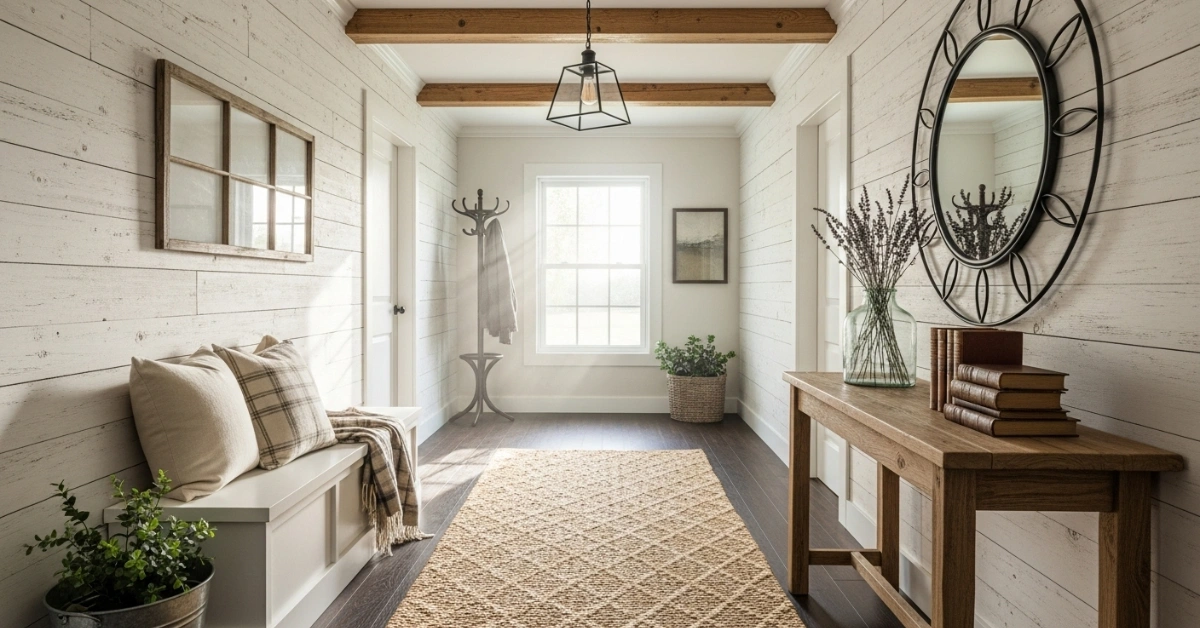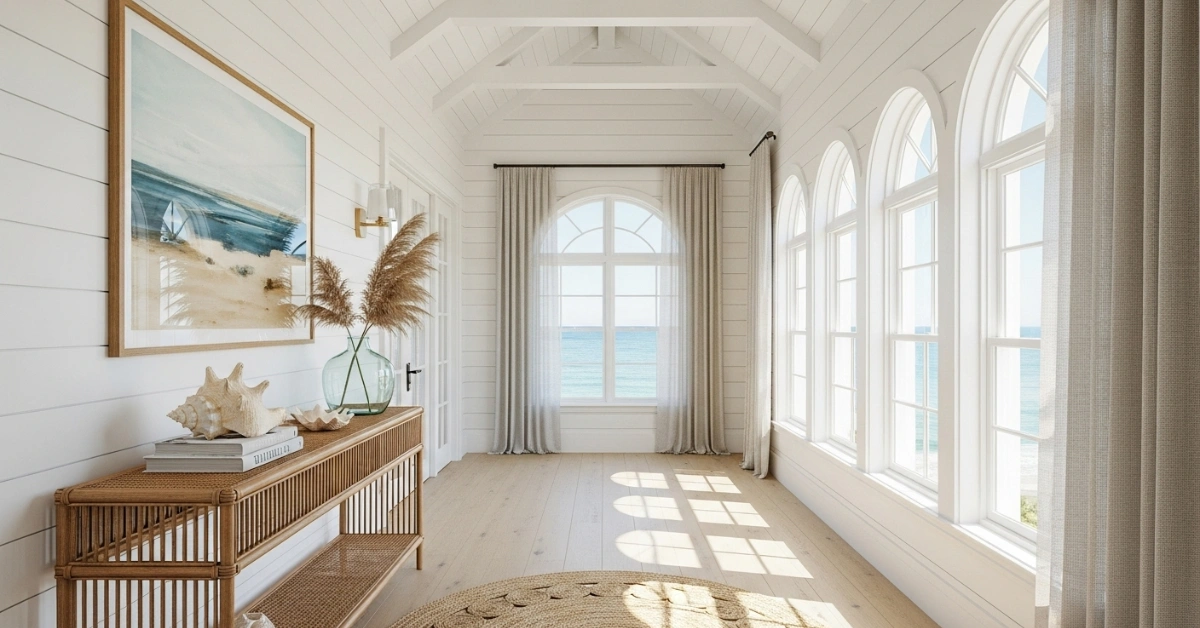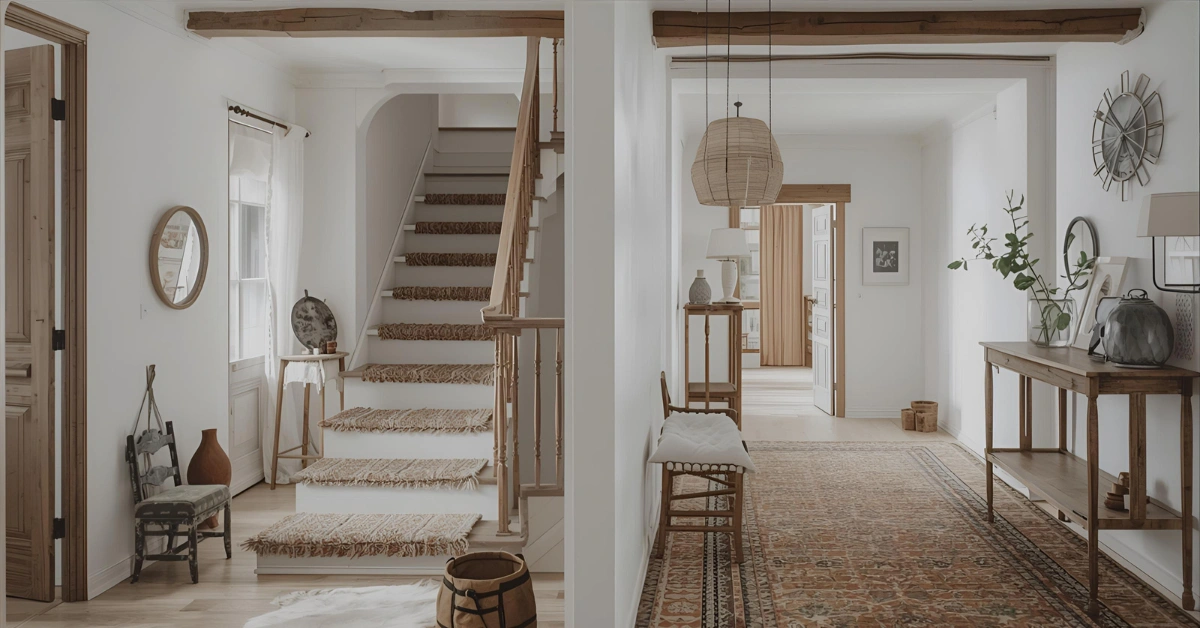Japandi Hallway Design Ideas for a Minimalist, Stylish Look
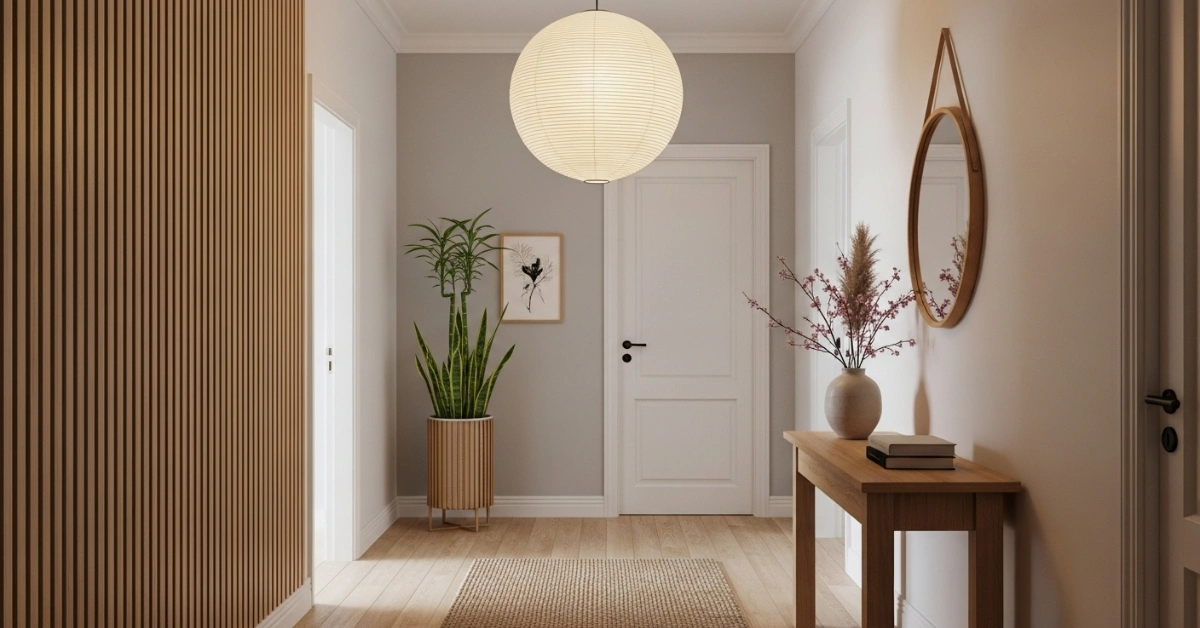
Hallways are often overlooked, left as mere passageways cluttered with shoes, coats, or random decor. Yet, a poorly designed hallway can make your home feel disjointed, uninspired, and chaotic. Imagine walking into a space that feels cramped, dark, or cluttered, it sets the wrong tone for the rest of your home. A well-designed hallway, however, welcomes you with calm, purpose, and beauty.
The Japandi hallway offers a perfect solution: a harmonious blend of Japanese minimalism and Scandinavian warmth. This design style transforms your hallway into a serene, functional, and visually appealing space. By combining clean lines, natural materials, and a neutral color palette, a Japandi hallway creates an inviting atmosphere that’s both timeless and practical. In this guide, we’ll explore how to create a stunning Japandi hallway with practical tips, design inspiration, and expert insights to elevate your home.
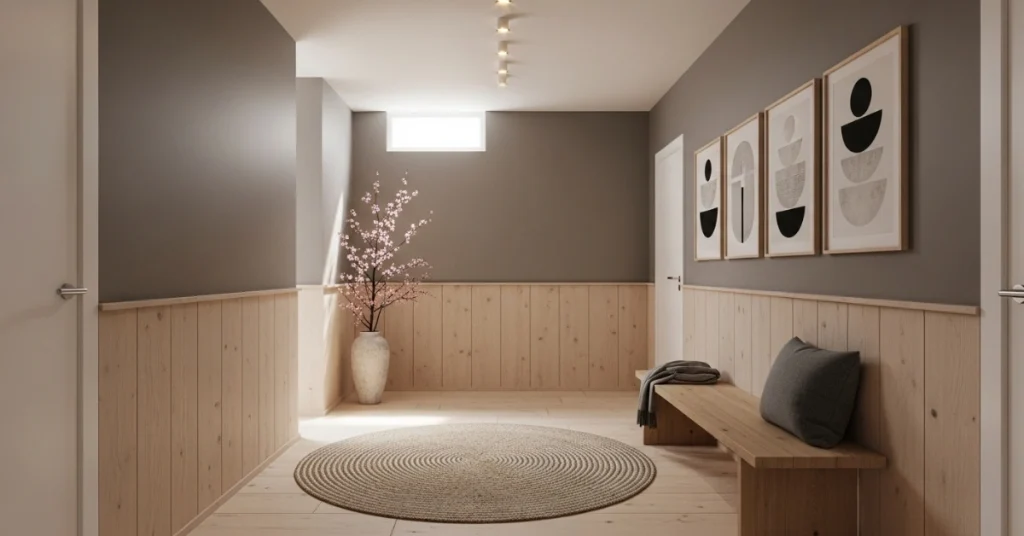
What is Japandi Style?
The Origins of Japandi Design
Japandi is a hybrid interior design style that merges Japanese aesthetics with Scandinavian functionality. According to Dwell, the style emerged as designers began blending the minimalist, nature-inspired principles of Japanese design with the cozy, practical elements of Scandinavian interiors (Dwell, 2023). The result is a look that’s clean yet warm, simple yet sophisticated.
- Japanese Influence: Emphasizes simplicity, natural materials like wood and bamboo, and a connection to nature.
- Scandinavian Influence: Focuses on functionality, light colors, and cozy textures like wool or linen.
This fusion creates a balanced aesthetic perfect for hallways, where space is often limited, but first impressions matter.
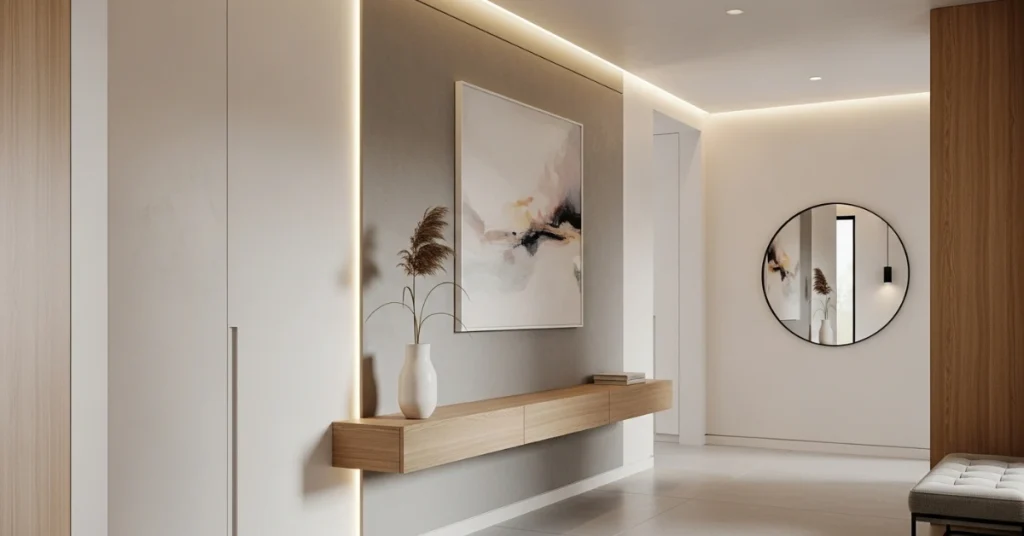
Key Characteristics of a Japandi Hallway
A Japandi hallway is defined by its ability to feel open, serene, and purposeful. Here are the core elements:
- Neutral Color Palette: Soft whites, beiges, grays, and muted earth tones create a calming backdrop.
- Natural Materials: Wood, stone, bamboo, and linen add texture and warmth.
- Minimalist Design: Clean lines and clutter-free spaces prioritize function and beauty.
- Functional Decor: Every item serves a purpose, from storage benches to sleek mirrors.
- Natural Light: Maximizing light through windows or reflective surfaces enhances the airy feel.
Interior designer Mia Hansen shares, “A Japandi hallway is about creating a moment of pause. It’s a space that feels like a deep breath, setting the tone for the rest of the home.”
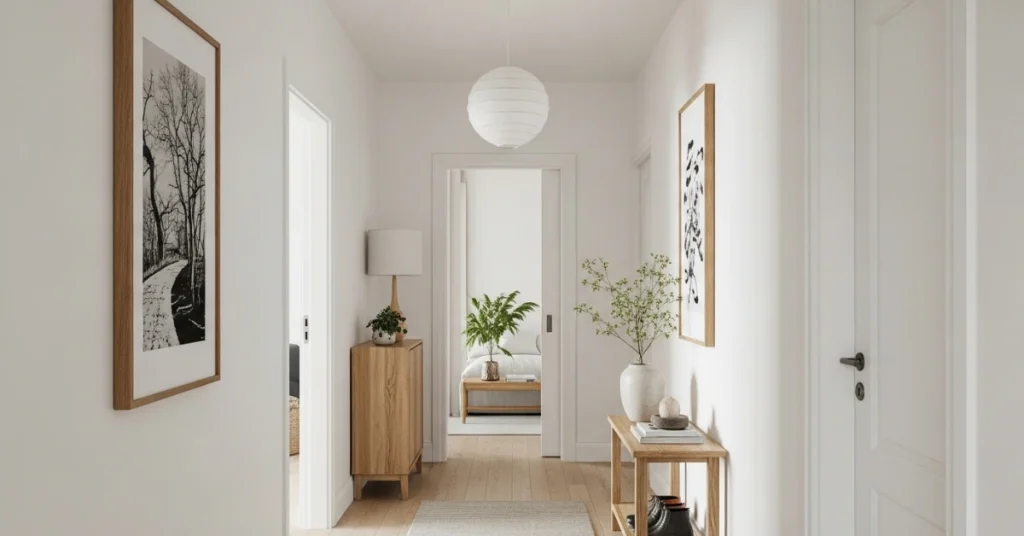
Why Choose a Japandi Hallway?
Hallways are transitional spaces, but they’re also opportunities to make a statement. A Japandi hallway offers unique benefits:
- Timeless Appeal: Its simplicity ensures it won’t feel dated in a few years.
- Space Optimization: Minimalist design makes even narrow hallways feel spacious.
- Versatility: Works in modern apartments, traditional homes, or anything in between.
- Calming Atmosphere: Neutral tones and natural materials promote tranquility.
For example, in my own home, transforming a narrow, dim hallway with Japandi principles, light oak flooring, a single woven runner, and a sleek console table made the space feel twice as large and infinitely more inviting.
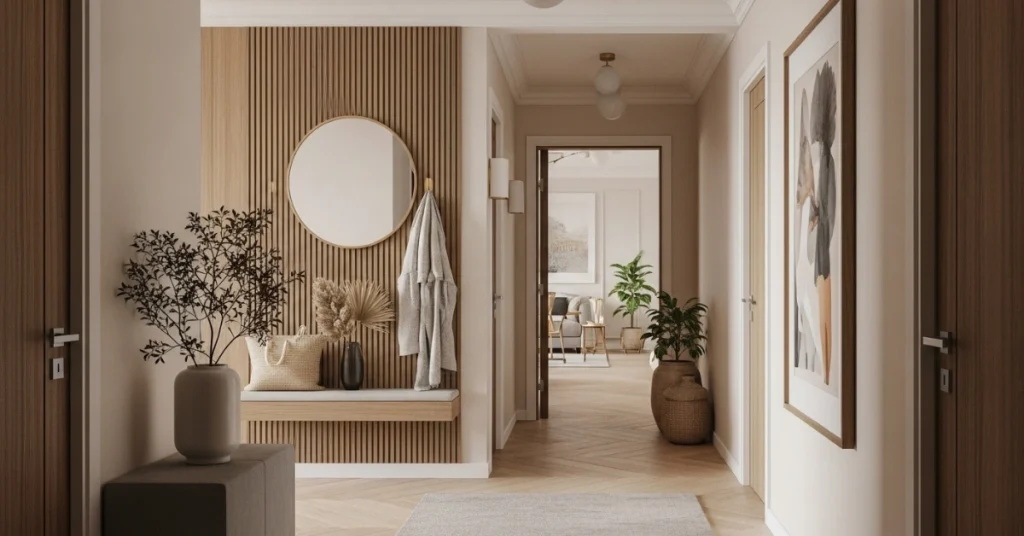
Designing Your Japandi Hallway: Step-by-Step Guide
Step 1: Declutter and Simplify
The first step to a Japandi hallway is removing clutter. Hallways often become dumping grounds for shoes, bags, and miscellaneous items. Start by assessing what’s essential and finding smart storage solutions.
- Practical Tip: Invest in a slim storage bench with hidden compartments for shoes or a wall-mounted coat rack to keep the floor clear.
- Example: A narrow hallway I worked on had a bulky shoe rack that overwhelmed the space. Replacing it with a minimalist wooden bench with built-in storage instantly opened up the area.
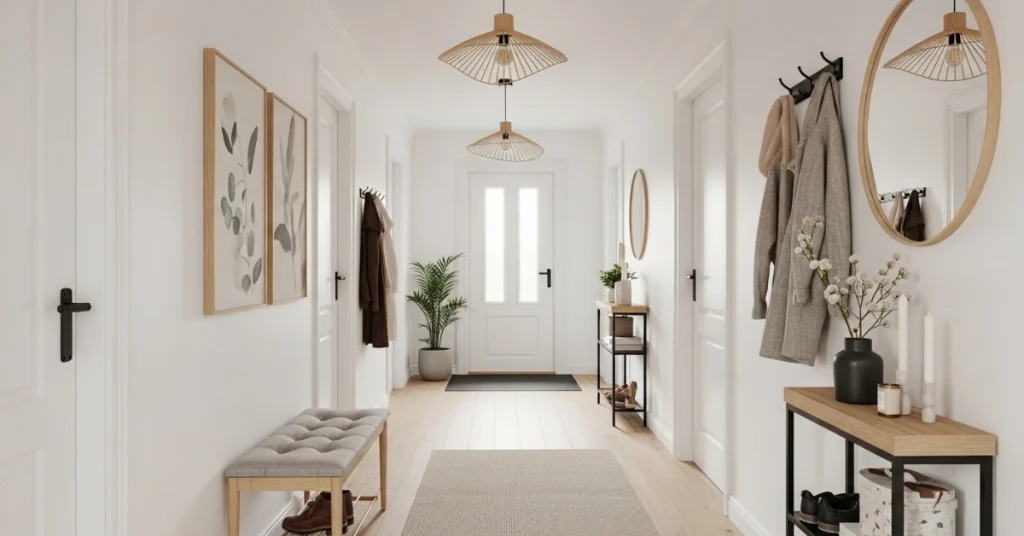
Step 2: Choose a Neutral Color Palette
A Japandi hallway thrives on soft, neutral tones. Think warm whites, soft grays, taupe, or muted greens. These colors make the space feel larger and more cohesive.
- Color Suggestions:
- Walls: Off-white or light beige for brightness.
- Accents: Charcoal gray or sage green for subtle contrast.
- Flooring: Light oak or ash wood for warmth.
- Expert Tip: “Avoid stark white walls—they can feel cold. Opt for a warm ivory or creamy beige to align with Japandi’s cozy aesthetic,” says designer Hiroshi Tanaka.
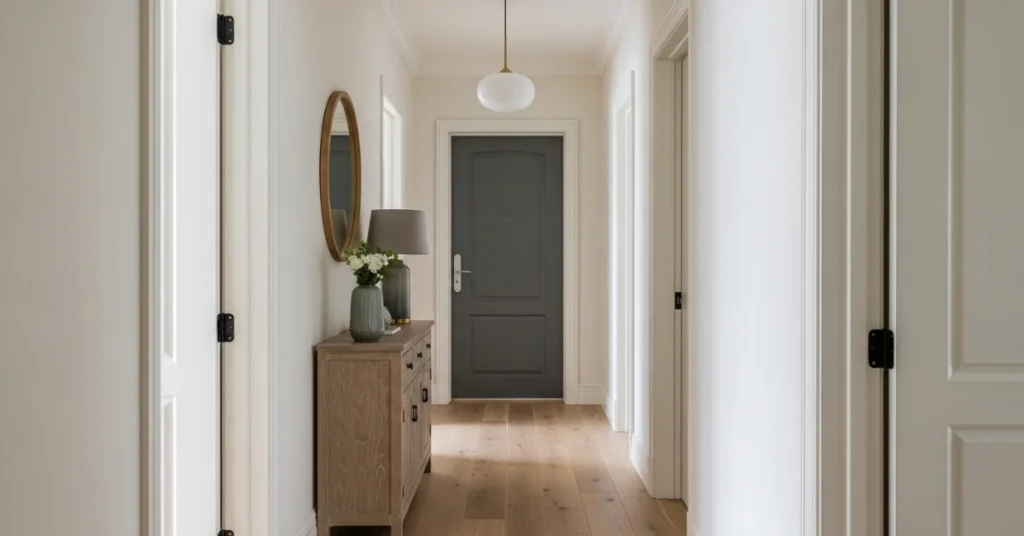
Step 3: Incorporate Natural Materials
Natural materials are the heart of a Japandi hallway. Wood is a staple, but stone, bamboo, and linen also play a role.
- Wood: Use light oak or maple for flooring or furniture like a console table.
- Bamboo: A bamboo mirror frame or coat rack adds texture without overwhelming.
- Linen: A linen runner or wall hanging introduces softness.
For instance, a client’s hallway felt sterile with its plain tile floor. Adding a light wood plank floor and a woven jute runner transformed it into a warm, inviting space.
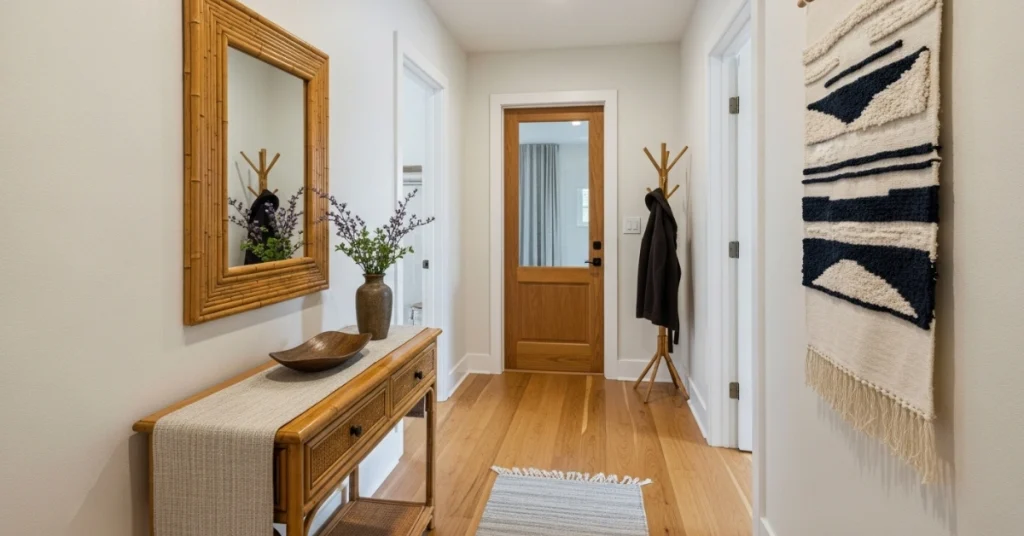
Step 4: Maximize Natural Light
Light is crucial in a Japandi hallway, especially in narrow or windowless spaces. If your hallway has windows, keep them unobstructed with sheer curtains or no coverings at all.
- Tips for Dark Hallways:
- Install a large mirror to reflect light and create the illusion of space.
- Use wall sconces with warm, soft lighting to mimic natural light.
- Choose glossy or semi-glossy paint to bounce light around.
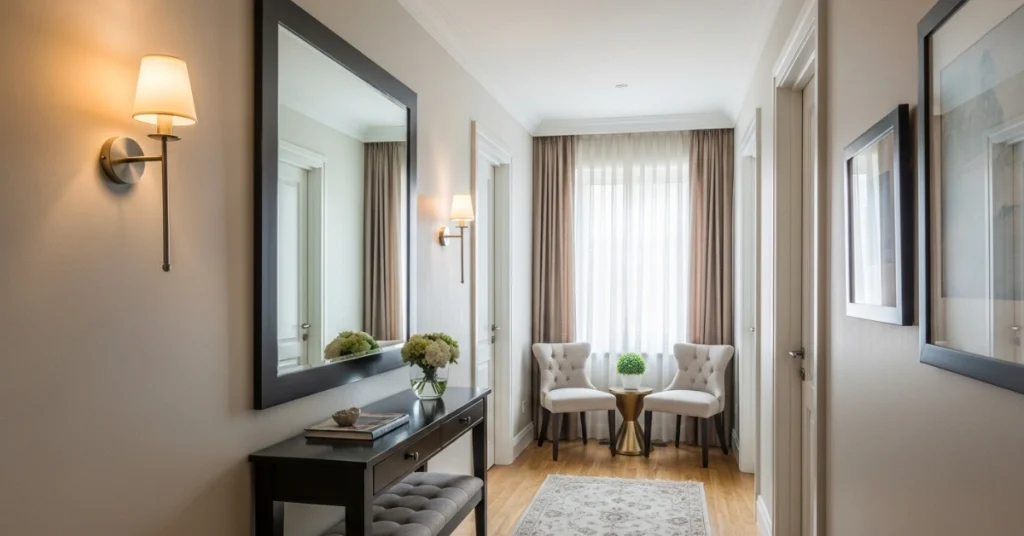
A hallway I designed had no windows, but adding a large round mirror and two minimalist wall sconces made it feel bright and open.
Step 5: Add Functional Decor
Every piece in a Japandi hallway should serve a purpose. Avoid purely decorative items that clutter the space.
- Ideas for Functional Decor:
- A slim console table for keys or mail.
- A woven basket for umbrellas or scarves.
- A single piece of art, like a minimalist print or Japanese ink painting.
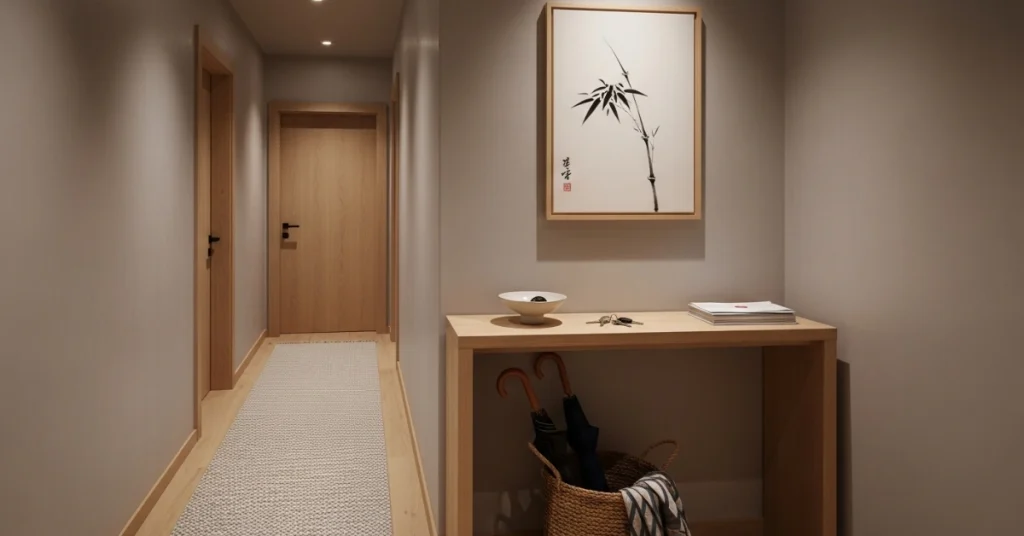
Designer Lena Sørensen advises, “Choose one or two statement pieces that draw the eye without overwhelming the space. A single ceramic vase or a textured wall hanging can be enough.”
Step 6: Incorporate Greenery
Plants bring the Japandi connection to nature indoors. In a hallway, space is limited, so choose small, low-maintenance plants.
- Plant Ideas:
- A potted bonsai on a console table.
- A hanging fern in a corner.
- A small snake plant for a pop of green.
- Care Tip: Opt for plants that thrive in low light, as hallways often lack direct sunlight.
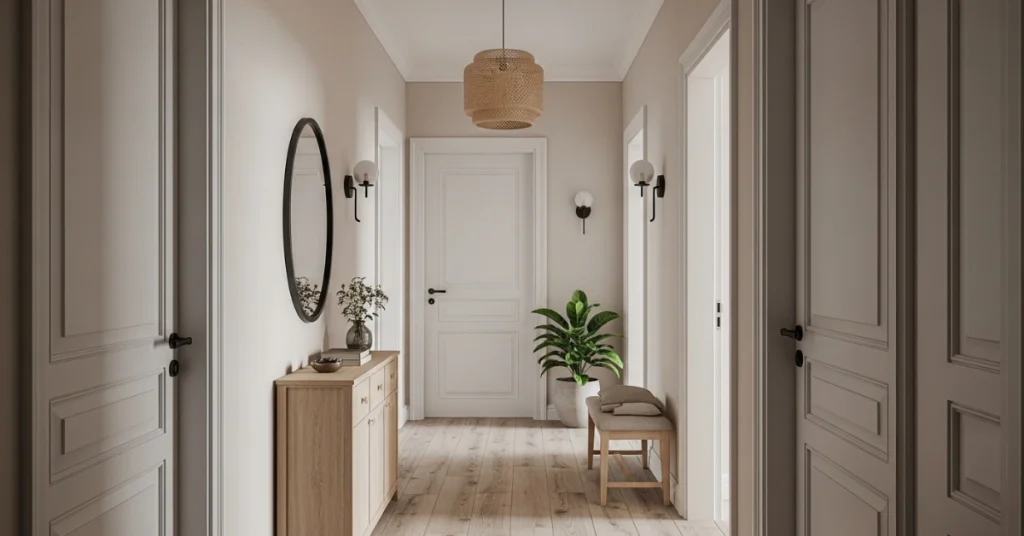
Japandi Hallway Design Ideas and Inspiration
Idea 1: The Minimalist Console Table Setup
A sleek console table is a Japandi hallway staple. Choose one in light wood with clean lines and pair it with a round mirror above.
- How to Style:
- Place a small ceramic vase with a single branch or flower.
- Add a woven tray for keys or small items.
- Keep the rest of the table clear for a minimalist look.
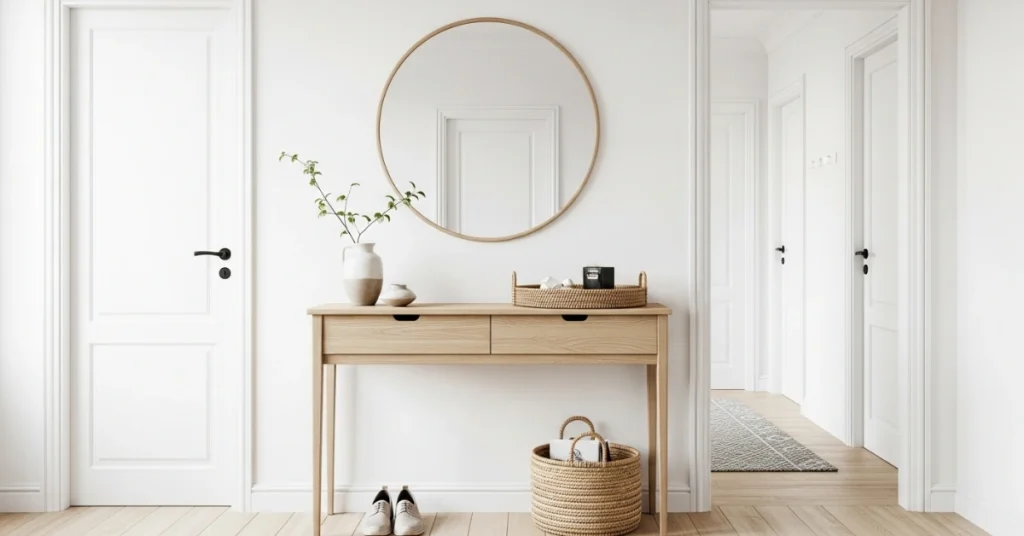
This setup works in narrow hallways, creating a focal point without taking up too much space.
Idea 2: The Woven Runner Look
A woven runner in neutral tones adds texture and warmth to a Japandi hallway. Opt for materials like jute, wool, or cotton in beige, gray, or muted green.
- Styling Tip: Choose a runner with a subtle geometric pattern to add interest without overpowering the space.
- Example: In a recent project, a gray wool runner with a diamond pattern tied together a long, narrow hallway, making it feel cohesive and cozy.
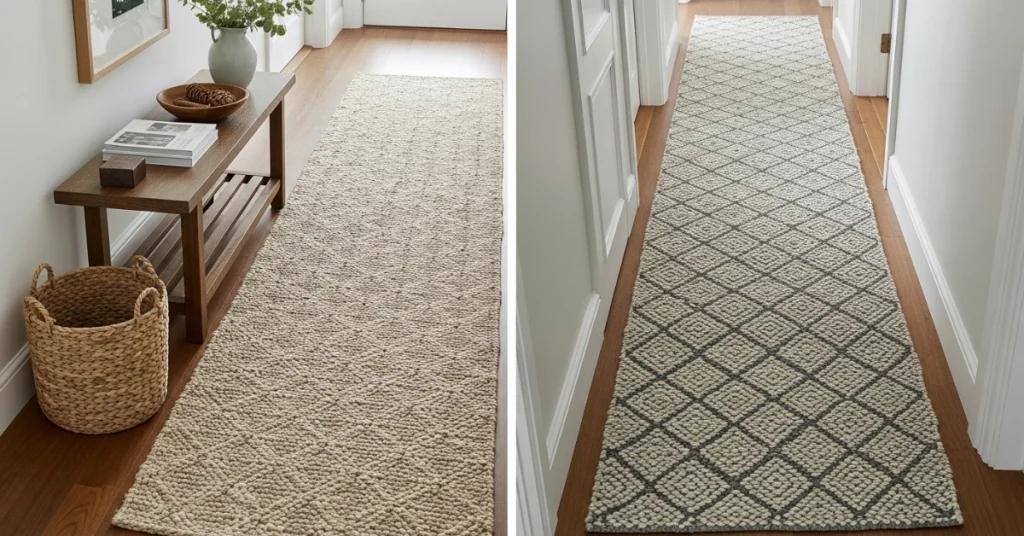
Idea 3: Wall Art with Purpose
A single piece of art can elevate a Japandi hallway. Consider a Japanese ink painting, a minimalist landscape, or a framed textile.
- Placement Tip: Hang art at eye level, centered on a blank wall, to draw attention without cluttering.
- Inspiration: A client chose a black-and-white ink drawing of a bamboo stalk, which added elegance to their hallway without overwhelming the space.
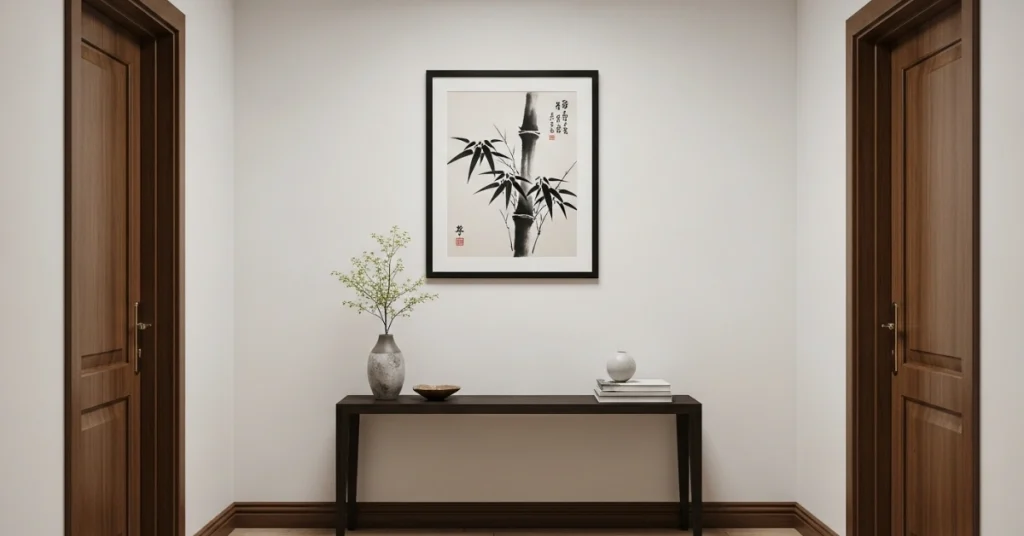
Idea 4: Floating Shelves for Functionality
Floating wooden shelves are perfect for displaying small plants, books, or decorative items while keeping the floor clear.
- Design Tip: Use shelves in the same wood tone as your flooring for a cohesive look.
- Example: A narrow hallway I designed had a single floating shelf with a small potted plant and a ceramic bowl, adding personality without clutter.
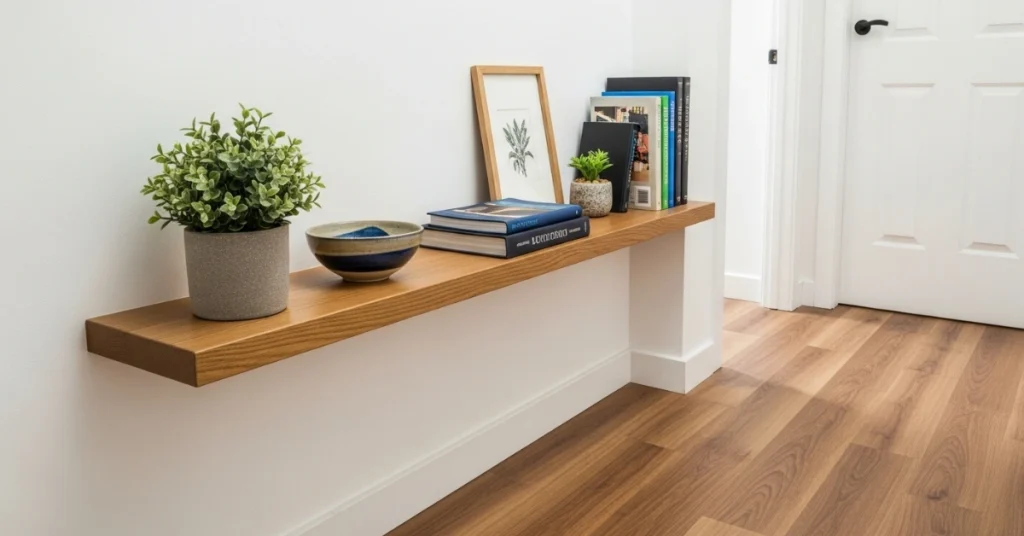
Idea 5: Statement Lighting
Lighting can be both functional and decorative in a Japandi hallway. Choose minimalist fixtures like ceramic pendant lights or wooden wall sconces.
- Lighting Ideas:
- A single pendant light with a woven shade.
- Wall sconces with warm, diffused light.
- A floor lamp with a linen shade for corners.
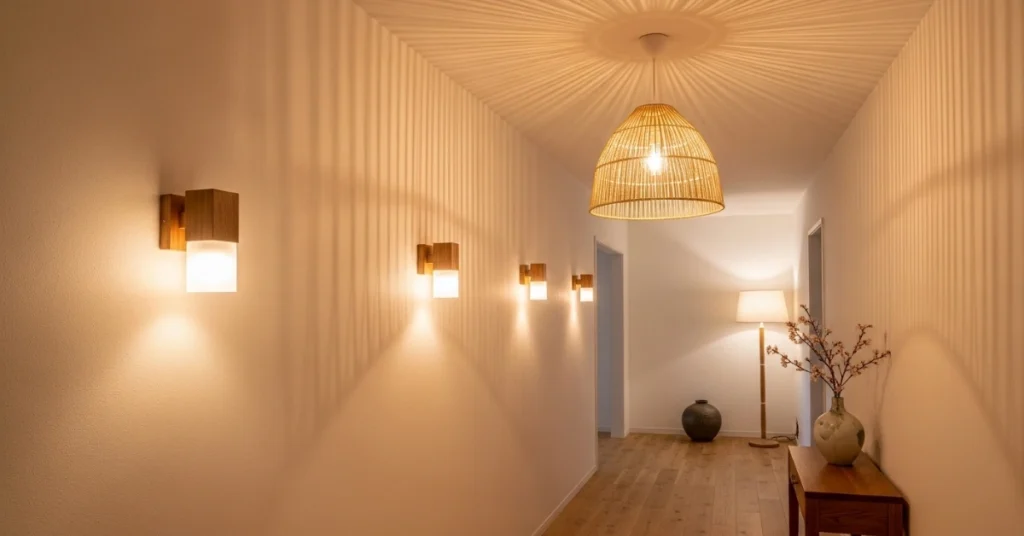
Designer Aiko Yamada notes, “Lighting in a Japandi hallway should feel soft and organic, like candlelight, to enhance the cozy atmosphere.”
Common Mistakes to Avoid in a Japandi Hallway
Even with the best intentions, it’s easy to stray from the Japandi aesthetic. Here are pitfalls to avoid:
- Overcrowding: Too many decor items can make the hallway feel cluttered. Stick to one or two statement pieces.
- Harsh Colors: Bright or bold colors disrupt the serene vibe. Stick to neutrals and muted tones.
- Ignoring Functionality: Decorative items without purpose can make the space feel impractical.
- Poor Lighting: Dark hallways feel cramped. Always prioritize light, whether natural or artificial.
Japandi Hallway on a Budget
You don’t need a big budget to create a stunning Japandi hallway. Here are cost-effective tips:
- DIY Elements: Paint walls yourself in a warm neutral tone or refinish an old wooden table.
- Thrift Finds: Look for secondhand wooden furniture or woven baskets at thrift stores.
- Affordable Materials: Use peel-and-stick wallpaper with a linen texture instead of real linen panels.
- Shop Smart: Retailers like IKEA and H&M Home offer Japandi-inspired pieces at accessible prices.
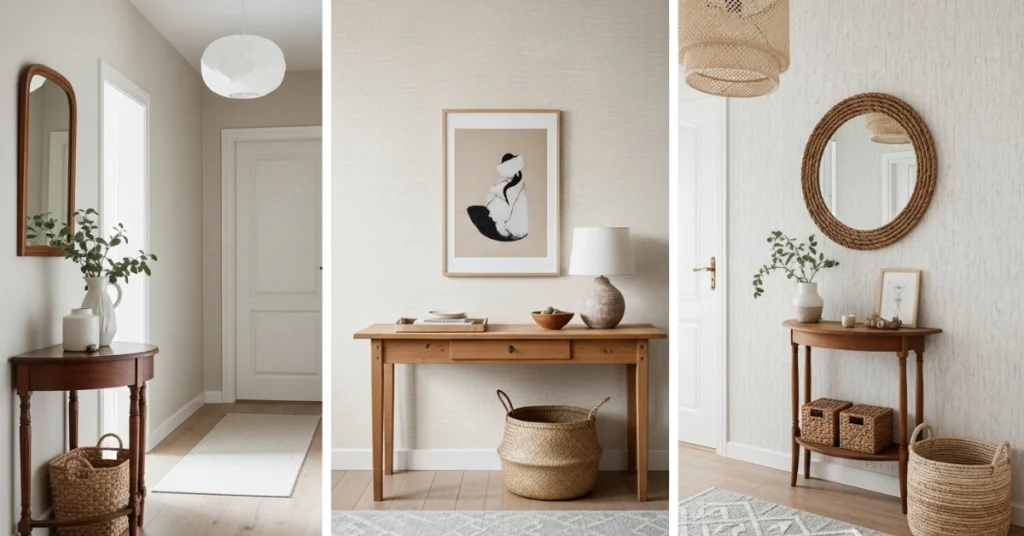
For example, I transformed a friend’s hallway on a tight budget by repainting the walls in a soft beige, adding a thrifted wooden bench, and using a jute runner from a discount store. The result was a cohesive, stylish Japandi hallway for under $200.
Maintaining Your Japandi Hallway
To keep your Japandi hallway looking fresh and timeless:
- Regular Decluttering: Remove items that accumulate, like stray shoes or bags.
- Clean Surfaces: Dust wooden furniture and wipe mirrors to maintain a polished look.
- Rotate Decor: Swap out plants or art seasonally to keep the space dynamic without adding clutter.
- Check Lighting: Replace bulbs promptly to ensure the hallway stays bright and welcoming.
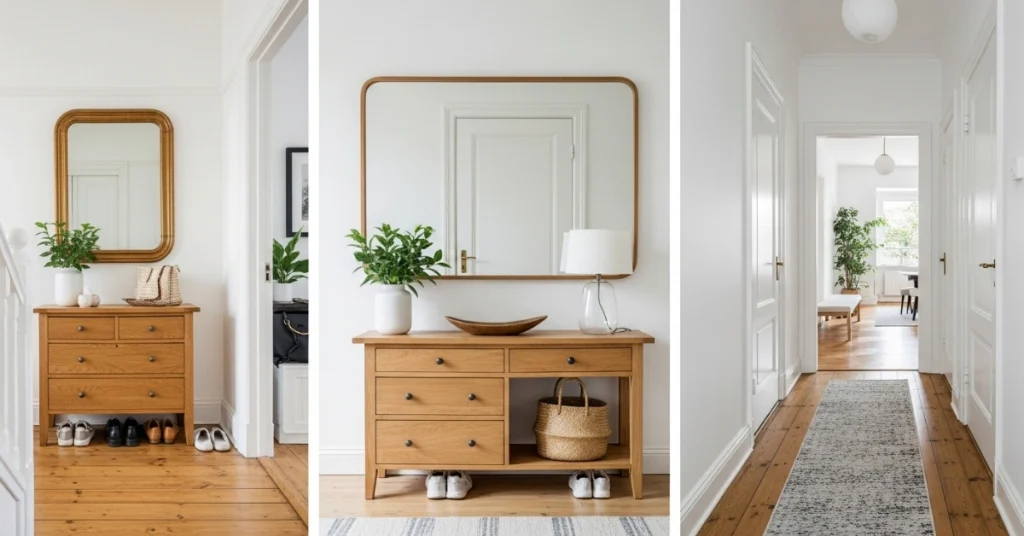
Japandi Hallway vs. Other Design Styles
| Style | Key Features | Best for Hallways? |
|---|---|---|
| Japandi | Minimalist, neutral, natural materials | Ideal for small, narrow spaces |
| Modern | Sleek, high-tech, bold colors | Can feel cold in hallways |
| Bohemian | Eclectic, colorful, layered textures | May feel cluttered in tight spaces |
| Traditional | Ornate, rich colors, heavy furniture | Overwhelming for hallways |
The Japandi hallway stands out for its balance of simplicity and warmth, making it ideal for creating a welcoming yet uncluttered space.
Conclusion: Create Your Dream Japandi Hallway
A Japandi hallway is more than just a passageway, it’s an opportunity to set the tone for your home with elegance and tranquility. By embracing minimalism, natural materials, and functional decor, you can transform even the smallest hallway into a space that feels open, inviting, and timeless. Whether you’re starting from scratch or refreshing an existing space, the principles of Japandi design offer endless inspiration.
Ready to get started? Subscribe to our newsletter for more design tips and inspiration to bring the Japandi hallway of your dreams to life!

